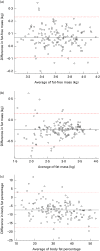Assessment of body composition in Indian adults: comparison between dual-energy X-ray absorptiometry and isotope dilution technique
- PMID: 25111193
- PMCID: PMC4189116
- DOI: 10.1017/S0007114514001718
Assessment of body composition in Indian adults: comparison between dual-energy X-ray absorptiometry and isotope dilution technique
Abstract
Dual-energy X-ray absorptiometry (DXA) and isotope dilution technique have been used as reference methods to validate the estimates of body composition by simple field techniques; however, very few studies have compared these two methods. We compared the estimates of body composition by DXA and isotope dilution (18O) technique in apparently healthy Indian men and women (aged 19-70 years, n 152, 48 % men) with a wide range of BMI (14-40 kg/m2). Isotopic enrichment was assessed by isotope ratio mass spectroscopy. The agreement between the estimates of body composition measured by the two techniques was assessed by the Bland-Altman method. The mean age and BMI were 37 (sd 15) years and 23·3 (sd 5·1) kg/m2, respectively, for men and 37 (sd 14) years and 24·1 (sd 5·8) kg/m2, respectively, for women. The estimates of fat-free mass were higher by about 7 (95 % CI 6, 9) %, those of fat mass were lower by about 21 (95 % CI - 18, - 23) %, and those of body fat percentage (BF%) were lower by about 7·4 (95 % CI - 8·2, - 6·6) % as obtained by DXA compared with the isotope dilution technique. The Bland-Altman analysis showed wide limits of agreement that indicated poor agreement between the methods. The bias in the estimates of BF% was higher at the lower values of BF%. Thus, the two commonly used reference methods showed substantial differences in the estimates of body composition with wide limits of agreement. As the estimates of body composition are method-dependent, the two methods cannot be used interchangeably.
Figures

References
-
- Wolfe RR (2006) The underappreciated role of muscle in health and disease. Am J Clin Nutr 84, 475–482 - PubMed
-
- Dulloo AG, Jacquet J, Solinas G, et al. (2010) Body composition phenotypes in pathways to obesity and the metabolic syndrome. Int J Obes (Lond) 34, Suppl. 2, S4–17 - PubMed
-
- Loveday SJ, Thompson JM & Mitchell EA (2012) Bioelectrical impedance for measuring percentage body fat in young persons with Down syndrome: validation with dual-energy absorptiometry. Acta Paediatr 101, e491–e495 - PubMed
Publication types
MeSH terms
Substances
Grants and funding
LinkOut - more resources
Full Text Sources
Other Literature Sources
Research Materials
Miscellaneous

